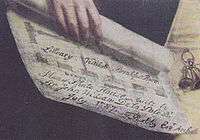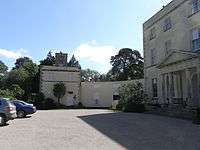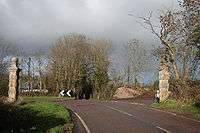New Shute House


New Shute House is a late Palladian country house built between 1785 and 1789 by Sir John de la Pole, 6th Baronet (1757–1799) and is situated within the grounds of Old Shute House, in the parish of Shute, near Axminster, East Devon. It was given Grade II* listing on 8 May 1967.[1] It was vacated by the Pole family in 1926 and was let between 1933 and 1974 to a girls' school. In 1974 it was sold by the family to a developer who converted it, together with stables and outbuildings, into 8 freehold apartments.[2] It remains in private ownership and the main block has now been converted back into a single residence from the two vertically divided apartments created in 1974.
History
The builder's 5 times great-grandfather William Pole Esquire (1515–1587), MP, had purchased Old Shute House in 1560 and had acquired a 1,200 year lease of the surrounding estate in 1562. The old house had been built in 1380 and had been substantially enlarged in the Tudor period and by William Pole's son Sir William Pole (1561–1635), the Antiquary. The 6th baronet, having determined to purchase the freehold of the Shute estate from the Petre family, which was completed in 1787,[4] clearly considered the old house to be old-fashioned, and perhaps encouraged by his wife Anne Templer,[5] whose father had just built Stover House in 1777 at Teigngrace near Newton Abbot, he decided to demolish half of it and build a new Palladian house about 1/2 a mile to the south. The demolition was carried out in 1785. The contemporary historiam Polwhele wrote in about 1806:[6]
"Sir John William de la Pole lately destroyed a great part of a very old seate within the manor of Shute, called Shute House. He has now finished another upon a larger scale. New Shute House, begun in 1787, is distant from the old mansion two furlongs south east. It is pleasantly situated under Shute Hill. The aspect is nearly south by east. It is a beautiful three quarter view in front with a very handsonme lawn. The English Channel is distant about four miles".
The decision to build was certainly a hasty one as a field of growing corn was cut down to lay the foundations. The family moved to temporary lodging at Colyton House in nearby Colyton where they remained for two years.[7] That part at least of the ancient mansion has survived is unusual, as often in the case of 18th. century re-builds the new house was built on the exact site of the old, which was either completely demolished or incorporated beyond recognition into the new structure.[8] Clearly the old site was considered unsuitable, perhaps being too close to the village and parish church of Shute, and whilst the mediaeval house may have been sited with its defensibility as a prime criterion, the new site was more spectacular and had views to the sea.
Architect

The identity of the architect as Thomas Parlby, the uncle of Lady Anne Pole and business partner of her father the self made magnate James Templer, was first discovered by Maureen Turner in her 1999 MA dissertation. The identity had eluded both Pevsner and Bridie, the principal historian of the two buildings. Pevsner had written "One would like to know the architect of this handsome late Palladian composition of 1787". Whilst at Antony House in Cornwall researching the Pole family Turner inspected closely the roll of paper held in the right hand of Sir John Pole the builder in his portrait, and discovered thereon drawn a partial plan of the new house with the following words written beneath: "Plan of Shute House built by Sir John William De la Pole Bt. July 1787, T. Parlby Esqr. Archt." Thomas Parlby (1727–1802) was of humble origins, the son of John Parlby of Chatham, Kent [9] or possibly from Gravesend.[10] He was for all of his adult life one of a trio of business partners with John Line and James Templer (1722–1782), in the business of constructing dockyards, generally under government contract.
James Templer
James Templer 1722–1782) had married Mary Parlby (d.1784), his partner's sister, and his daughter was thus the future Lady Anne Pole. Templer was a self-made magnate. He was born in Exeter of a humble family, the son of Thomas Templer a brazier. He was orphaned young, whereupon his elder brother apprenticed him to John Bickley, a carpenter or architect of Exeter. He broke his indenture and set off for India where he made a fortune, either from government building contracts or possibly from dealing in silver bullion,[11] before returning to England aged 23. He settled at Rotherhithe, Kent, where he obtained a government contract to re-build the dockyard with his partners John Line and Thomas Parlby. He married Mary Parlby (d.1784), the sister of his business partner and daughter of John Parlby of Chatham, Kent. He obtained with his partners in about 1760 the contract to rebuild Plymouth docks, for which he used granite from Haytor, and moved to Devon. In 1763 he obtained a grant of arms from the College of Arms, and in 1765 purchased the manor of Teignrace and Stover Lodge, which in 1780 he re-built in grander form on a nearby site. He died in 1782 and is commemorated by a monument in Teignrace Church, rebuilt in 1786 by his sons. Both Line and Parlby settled in Devon close to Templer, and both likewise each acquired a great country house and estate. John Line purchased Lindridge House, Bishopsteignton, which on his death he bequeathed to Templer's younger son and his own godson Henry Line Templer (d.1818), from whose heirs it was purchased by his elder brother Rev. John Templer (d.1832), and where Lady Anne Pole ended her days nursing her brother, as her mural monument in Shute Church states.
Thomas Parlby
Thomas Parlby (1727–1802) was described in his obituary in the Gentleman's Magaziner as "Master Mason of HM Docks".[12] Parlby married in 1748 Lydia Martyn.[13] He resided at Stone Hall, Stonehouse, in Plymouth,[14] "the big house overlooking Stonehouse Pool".[15] He rebuilt the old chapel at Stonehouse in 1787 and his 1802 monument, by Peter Rouw of London (who also made the monuments to Sir John Pole and his wife Lady Anne in Shute Church), was situated in the new church,[16] apparently destroyed by World War II bombing. Templer and Parlby were the government contractors who rebuilt Plymouth Dockyard in 1763, and nearly doubled it in size by levelling the hill to the south and replacing all the buildings except the officers' accommodation.[17] One of these docks is still known as "Parlby Dock". The same partnership also built between 1779–85 in the classical style the Royal Marine Barracks on Durnford Street, Stonehouse, Plymouth, which still survive on three sides of a courtyard now closed by 19th-century additions, described by Copper Plate Magazine as " a fine pile of buildings".[18] Parlby also in a smaller commission rebuilt the kitchens at Saltram House after the fire of 1778, "a fine lofty room with a coved ceiling".[19] Parlby had the following progeny:
- Priscilla Parlby
- James Templer Parlby (d.1826), so named no-doubt from Templer having been his godfather, is commemorated by a monument at Berhampore, Bengal, India as follows: "Sacred to the Memory of Lieutenant-Colonel Commandant James Templer Parlby, of the Corps of Engineers, who died on the 1st December 1826, during a very long residence at Berhampore. He displayed the virtues which characterize and adorn the English gentleman, and his Monument is erected by his friends at the station as a memorial of their attachment, aged 64 years" [20]
- John Alexander Parlby (d.1849), JP, who married in 1792 Laetitia Hall (d.1848), daughter and co-heir of Humphrey Hall of Manadon, Crown Hill, Plymouth and Goldings, Herts, by his wife Jane St John, daughter of John St John, 10th Baron St John.[21] The mansion of Manadon, built in 1681, is now the administrative headquarters of the Royal Naval Engineering College, Tavistock Road, Manadon.[22]
Cecil St John Hall Parlby (b. 1912) still owned Manadon in 1937, and was also lord of the manors of Weston Peverell and Sampford Spiney. His brother John Reginald Hall Parlby (b. 1916) in 1937 lived at Stonehouse, Bishop's Hill, Taunton.[23]
Construction
The house was built using labour from distant Plymouth, as an invoice dated 1798 from a builder of that city named John Bellman reveals.[24] The travelling costs of various workmen between Plymouth and Shute were also charged.[25] These men were therefore probably favoured tradesmen used before by Parlby, as more local Exeter labour appears not to have been used.
Description


The house consists of a central stuccoed block of three floors with a basement divided into five bays, with a flanking pavilion of two stories in four bays, to either side connected by low flanking quadrant walls. In the centre of the front is a large classical pedimented portico fronted by four Ionic columns. The flanking walls screen the service wings behind. The rear elevation has on either side full-height semi-circular bays. The interior contains much Adam style decorative plasterwork, apparently the work of a certain Mr Powell referred to in the invoice from the builder Bellman,[26] and ornamental fittings. Robert Adam did much work for the Parkers at Saltram House near Plymouth between 1768–72 and 1779–82.[27] The Poles are likely to have been guests at their neighbours at this time, but in any case as they also spent much time in London at their house in Bedford Square, they would have been familiar with Adam's work in London and elsewhere. The north-east pavilion contains a theatre of circa 1900.[28] The top floor housed the servants' quarters.[29] The kitchens were originally situated in the left hand pavilion, later converted into a theatre.[30] A large Palladian style stables block is situated around a semi-circular courtyard, several hundred yards from the house, now converted into several separate residences. It had stabling for twelve horses and accommodation for grooms.
Interior
The front door opens into a vestibule or hall 15 ft wide which runs to the rear wall of the house.[31] To the left is the Library, in which was painted the portrait by Thomas Beach of Sir John Pole, in which the portico is visible through the window. It contained originally a large Sheraton book-case 11 ft wide and 10 ft high.[32] Further back on the left-hand side beyond a small parlour or smoking room and service staircase lobby, is the Drawing room, 35 ft in length, with full-width bay window in its rear wall, giving extensive views towards the sea. The plasterwork by Bellman on the ceiling of the bay shows the signs of the Zodiac arranged as a semi-circle, with at the centre the Pole coat of arms. The hall is crossed from the drawing room to reach the slightly longer Dining room (40 * 23 ft, 15 ft high[33]), also with full width bay window and containing Corinthian columns. In the Dining Room was hung the famous and immensely valuable life-size portrait of Lady Anne Pole by Romney, and the matching one of her husband. At the front of the house on the right-hand side is the Breakfast Room, as shown on the plan held in his hand in the portrait of Sir John Pole. The main staircase, of shallow-stepped cantilever design without visible support, made from Portland stone, is situated at the rear of the hall and runs around three walls, the rear wall of the house and the two side walls of the hall. On the first floor landing is a large stained glass window displaying the Pole crest.[34] The present house retains most of the original fittings and decorative plasterwork.[35]
Grounds


The site of New Shute House is sloping from the front to the back of the house, which allows for an uninterrupted view of the distant sea. The Poles may have been influenced by the landscaping at Mount Edgecumbe House near Plymouth,[36] Saltram and Killerton House.[37] Pole employed John Veitch, Sir Thomas Acland's head gardener at Killerton, as his landscape designer, who contracted in 1790 to complete the works, which included the making of new roads and fences, by 29 September 1794.[38] Pole planted a large number of young trees, including 1,000 larch and 950 Spruce, as an invoice from the firm Gould Smith dated November 1797 records.[39] Veitch also made the new road to Shute village beyond the Elizabethan Shute Gatehouse ("the Old Lodge") and onward to the road leading to "Shute Piers", about one mile away.[40] The contract specifies: "Toward the lodge...let the road be sunk three feet deeper than the ground is at present as it passes between the Old House and the Church to give more room under the Lodge and also to produce ground for forming the plantation each side intended to cover the said Old House, stables and the churchyard; also to form a plantation ground by raising it up for planting against the walls on each side of the lodge so as when planted and grown-up the said lodge may only appear between the said plantations".[41] Bridie had noted in her work that the lower windows of the gatehouse were now below ground level, but had not ascertained the reason.
References
- ↑ Listed Building text "Shute House"
- ↑ Turner, p.6
- ↑ Bridie, p.150
- ↑ Pulman, George P.R., The Book of the Axe, Bath, 1969, p.765
- ↑ Turner, p.19
- ↑ Polwhele, Richard, The History of Devonshire, 1793–1806, published 1806, p.315
- ↑ Turner, p.21
- ↑ c.f. e.g.Castle Hill, Filleigh (1730), Poltimore House, etc.
- ↑ Following quoted from Proceedings of the ICE (Institution of Civil Engineers), Engineering History and Heritage, Volume 163, Issue 3, 1 August 2010 , pages 189–198 "James Templer (1722–1782) and Thomas Parlby (1727–1802) were men of humble origin who became prominent contractors in the second half of the eighteenth century, working mainly, though not exclusively, in the royal dockyards for the Navy Board. Over 40 projects have been attributed to them or to one of their constituent organisations. England's quest for maritime supremacy throughout the eighteenth century led to an expansion in the royal dockyards, requiring large-scale civil engineering and building projects. These were undertaken variously by dockyard workers or by external contractors or, sometimes, both working together. Templer, a house carpenter and Parlby, a stonemason, emerged from the ranks of artisans to create a large and effective workforce operating across the south of England. Between them, they acquired properties in London, Middlesex, Kent, Hampshire, Wiltshire, Dorset and Devon. Although their businesses brought them wealth and social standing, their interests were not pursued by later generations of either family and their firms shrank into obscurity after 1802"
- ↑ Turner states Parlby to have been from Gravesend, quoting "Thorne, History of Parliament, p.358"
- ↑ Extract from www.templerfamily.co.uk: "The log of one of the East India Company ships which was carrying silver bullion suggests that on arrival in Madras the bullion was handed over to a small group consisting of, amongst others, Line and Templer. Another snippet derived from a remote family source is that James Templer and his partners were actually trading in Mexican silver dollars, but why and how they came by the dollars is not explained. However, there are two other possibly completely irrelevant facts worth noting. The first is that adulterated silver became a problem in India, and secondly that James's father and elder brother were both 'braziers', i.e. brass craftesmen, so James would have had some knowledge of foundries and metallurgy. In a printed book of the Madras Record Office Extracts to be found in the Society of Genealogists Library, there is evidence that he was engaged in transactions, legalised by the Madras Mint, in connection with exchanging old and new Mexican silver. In view of James' young age, it seems likely that this was the main basis of his later fortune rather than the building of docks"
- ↑ Gents Magazine obits. 1802/692
- ↑ "Thomas Parlby 1727–1802", Templer Trees
- ↑ Heraldic Visitation of England and Wales, Notes (1896–1921), Howard, Joseph Jackson, (14 volumes. [London]: Frederick Arthur Crisp, 1896–1921), FHL book 942 D23hn., vol. 13 p. 92 (quoted in "Thomas Parlby", Community Trees, Family Search)
- ↑ Gill; Plymouth, A New history, p.91
- ↑ Lysons, Magna Britannia, 1822, vol.6, Parishes: Slapton – South Sydenham, pp. 451–468
- ↑ Pevsner, pp.650–1
- ↑ Pevsner, p.655
- ↑ Pevsner, p.90
- ↑ Berhampore; Bengal Obituary p.382, Transcribed by British Library, India Office Records Reference: Bengal Obituary p.382 (quoted in Templer Trees)
- ↑ Burke's Landed Gentry, 1937, pp.1754–5, Parlby of Manadon
- ↑ Pevsner, p.656
- ↑ Burke's Landed Gentry, 1937, pp.1754, Parlby of Manadon
- ↑ Cornwall Record Office, PA/32/34 Invoice dated 1790 from Bellman
- ↑ Turner, p.21
- ↑ Turner, p.58
- ↑ Turner, p.28
- ↑ Listed Building text
- ↑ Turner, p.63
- ↑ Turner, p.65
- ↑ Turner, p.47
- ↑ Bridie, p.162
- ↑ Turner, p.52
- ↑ Turner, p.47; Bridie, p.163
- ↑ Turner, p.40
- ↑ Turner, p.71
- ↑ Turner, p.76
- ↑ Turner, p.78
- ↑ Cornwall Record Office PA/32/34, Gould Smith account 1797-8
- ↑ Turner, p.80
- ↑ Turner, p.80
Sources
- Pevsner, N., Buildings of England: Devon, 2004
- Thorne, R.G., Biography of Sir John de la Pole, 6th Baronet, published in History of Parliament: House of Commons 1790–1820, Volume 3]
- Turner, Maureen A., The Building of New Shute House 1787–1790, MA dissertation, Local & Regional History, University of Exeter, Sept 1999
- Bridie, Marion Ferguson, The Story of Shute: The Bonvilles and the Poles, Axminster, 1955. (Published by Shute School Ltd.), reprinted 1995, Bridport.
External links
Coordinates: 50°46′04″N 3°03′24″W / 50.7677°N 3.0568°W